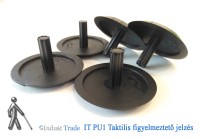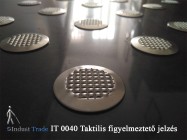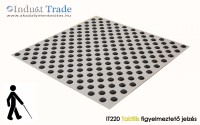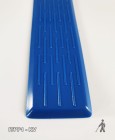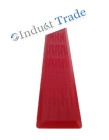INDOOR Tactile Markings and warning signs
The tactile marking is provide the blind and people with reduced and limited vision with useful information, it redounds to their safe traffic in such places where they would easily loose their orientation. It gives valuable information not only to people who have intense vision problem but to people using a white stick as well.
The tactile surface should be differ in color from the surrounding surface. They should be in contrast with the other places, it is suggested to have a bright colour (e.g. white or yellow) on darker surfaces, but using a darker colours (e. g. anthracite grey or black) on lighter surfaces. Furthermore these markings must be anti sparkling, anti reflecting, anti glittering, anti flashing, The change of the material of the tactile marking or the closing of it is drawing the attention to some kind of difference in the walking path. plus anti slipping and tumbling.
Built-into-the floor or afterward placed tactile guide marking is needed in such area where we can expect that that the blind and people with reduced or limited mobility are appearing regularly. The tactile marking is helping these people to be able to move alone on those path which is used often, well-known and clear. That person who is panning a new building or creating a new floor is in a more advantageous situation when making the tactile marking.
When making a new construction it is easier to use the different materials and there is no need to pace them onto the already existing surface. The tactile markings are practical to configure in a further distance from the wall, if the corridor is narrow they should be put in the middle. The configuration can be influenced by the function and the size of the corridor, the barriers on it, the main path of the people without disability etc. In such places where many people with vision disability is moving who are very well trained for walking on their own, the tactile marking can be solved only with a thin strip. Inside a building the marking system used in a well built consistency has the feature of signing the type of the upcoming chage. There is e.g. a stair, elevator, washing room or a branch is coming.
The way of placement:
• The wands run paralel with the walking way
• Before danger or the turn of the way is coming warning dot shaped marks needs to be placed
• There must be markings in the full size of the place before the upcoming danger
• The tactile marking should be ended with 40 cm before the area of attention
• The width of the tactile marking is 40 cm., in an optimal case it is 60 cm.
• The tactille marking should be higher from the surface with a minimum of 3 mm.
• The swell of the surface of the marking must be equipartition and anti slipping
• The suggested difference in luminance of the surface between the tacrile markings and the surrounding should be 30%
The system mentioned above can also be configured with the craggy change of the roughness of the surface also, plus using the coloring that draws attention. The way of installation is to place the 30-60 cm wide markings in a non stop way and when the change needs to be shown or attention is required because of danger, the the marking is stopped. When creating such system the markings need to be placed on the total width of the walking surface in front of the stairs and ramps.
The quantity of the marked points is depending on the frequency of the appearance of the peopple with vision disability int he buiding. In such often visited building, like a school it is very well requred to create the configuration on every public place in the buiding to ensue full accessibility fo the person with vision difficulties. We must use all available tools and services to provide them with the most support. In case of the non frequently visited public facilities the necessary markings should be simple and easy to realize. They should guide the visitors with vision difficulties to those most important public area which can be approached without help, e.g. the main entrance, the information panel, the information desk. On the other area of the buiding is suggested to use the floor cover changing tools which could work as a good guide for the blind or people with reduced or limited vision.
More
The tactile marking is provide the blind and people with reduced and limited vision with useful information, it redounds to their safe traffic in such places where they would easily loose their orientation. It gives valuable information not only to people who have intense vision problem but to people using a white stick as well.
The tactile surface should be differ in color from the surrounding surface. They should be in contrast with the other places, it is suggested to have a bright colour (e.g. white or yellow) on darker surfaces, but using a darker colours (e. g. anthracite grey or black) on lighter surfaces. Furthermore these markings must be anti sparkling, anti reflecting, anti glittering, anti flashing, The change of the material of the tactile marking or the closing of it is drawing the attention to some kind of difference in the walking path. plus anti slipping and tumbling.
Built-into-the floor or afterward placed tactile guide marking is needed in such area where we can expect that that the blind and people with reduced or limited mobility are appearing regularly. The tactile marking is helping these people to be able to move alone on those path which is used often, well-known and clear. That person who is panning a new building or creating a new floor is in a more advantageous situation when making the tactile marking.
When making a new construction it is easier to use the different materials and there is no need to pace them onto the already existing surface. The tactile markings are practical to configure in a further distance from the wall, if the corridor is narrow they should be put in the middle. The configuration can be influenced by the function and the size of the corridor, the barriers on it, the main path of the people without disability etc. In such places where many people with vision disability is moving who are very well trained for walking on their own, the tactile marking can be solved only with a thin strip. Inside a building the marking system used in a well built consistency has the feature of signing the type of the upcoming chage. There is e.g. a stair, elevator, washing room or a branch is coming.
The way of placement:
• The wands run paralel with the walking way
• Before danger or the turn of the way is coming warning dot shaped marks needs to be placed
• There must be markings in the full size of the place before the upcoming danger
• The tactile marking should be ended with 40 cm before the area of attention
• The width of the tactile marking is 40 cm., in an optimal case it is 60 cm.
• The tactille marking should be higher from the surface with a minimum of 3 mm.
• The swell of the surface of the marking must be equipartition and anti slipping
• The suggested difference in luminance of the surface between the tacrile markings and the surrounding should be 30%
The system mentioned above can also be configured with the craggy change of the roughness of the surface also, plus using the coloring that draws attention. The way of installation is to place the 30-60 cm wide markings in a non stop way and when the change needs to be shown or attention is required because of danger, the the marking is stopped. When creating such system the markings need to be placed on the total width of the walking surface in front of the stairs and ramps.
The quantity of the marked points is depending on the frequency of the appearance of the peopple with vision disability int he buiding. In such often visited building, like a school it is very well requred to create the configuration on every public place in the buiding to ensue full accessibility fo the person with vision difficulties. We must use all available tools and services to provide them with the most support. In case of the non frequently visited public facilities the necessary markings should be simple and easy to realize. They should guide the visitors with vision difficulties to those most important public area which can be approached without help, e.g. the main entrance, the information panel, the information desk. On the other area of the buiding is suggested to use the floor cover changing tools which could work as a good guide for the blind or people with reduced or limited vision.
Less




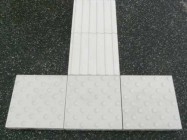
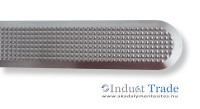
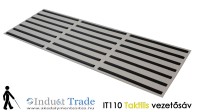
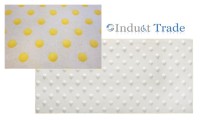

.jpg&w=200&h=140&zc=3&a=t)


